Analysis of Structure, Staffing, and Trends in Hospitality Industry
VerifiedAdded on 2023/04/10
|14
|3488
|109
Report
AI Summary
This report provides a comprehensive analysis of the contemporary hospitality industry, focusing on its structure, scale, scope, and diversity. It examines the organizational structures of different hospitality industries, including Hilton Hotels and McDonald's, highlighting the roles of hospitality organizations and professional bodies. The report details staffing requirements, roles, responsibilities, and qualification requirements within the industry. It addresses current issues affecting hospitality, such as the dynamic characteristics of the industry, and predicts future trends and developments, analyzing their potential impact. The study emphasizes the importance of skilled personnel and the role of professional bodies in bridging the gap between job seekers and providers in the UK hospitality sector.
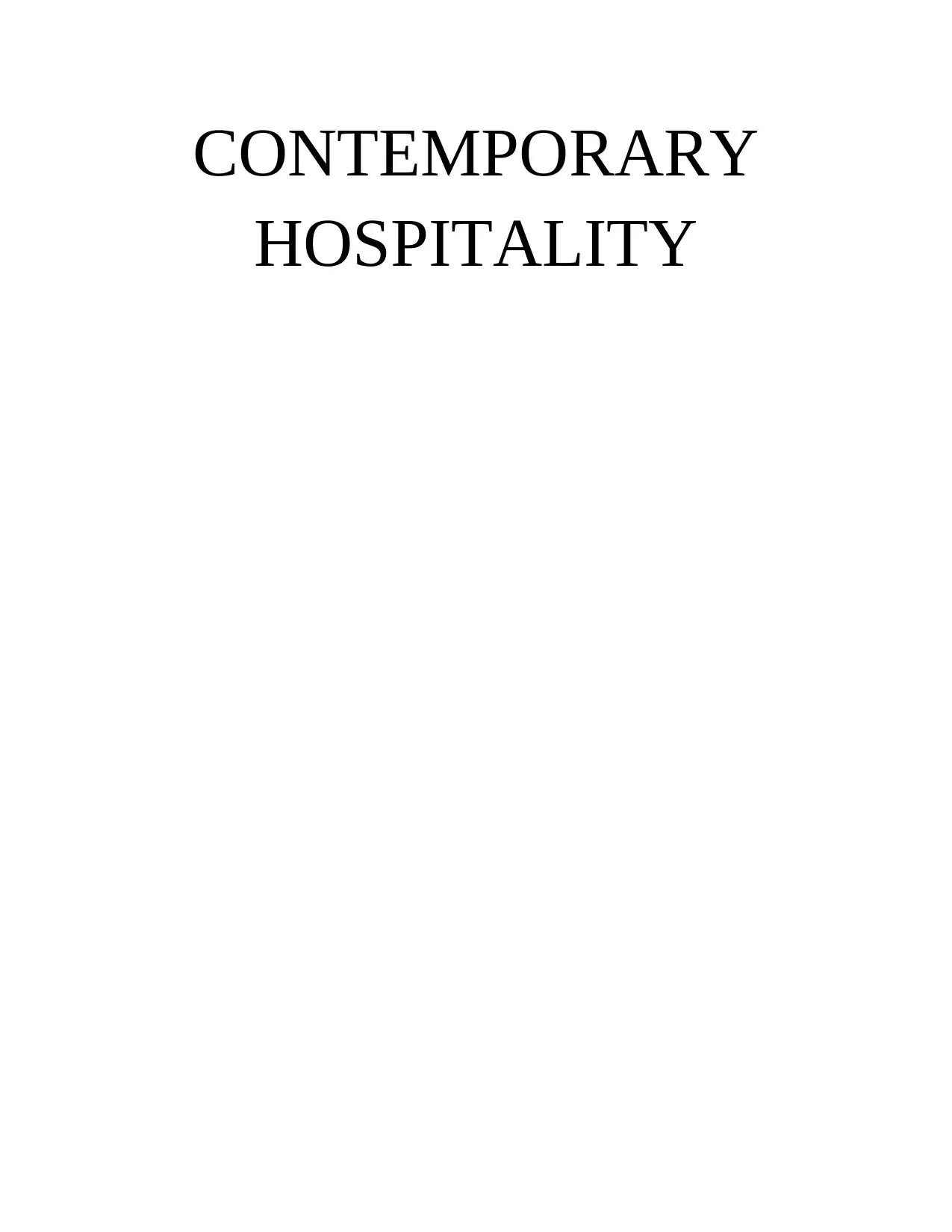
CONTEMPORARY
HOSPITALITY
HOSPITALITY
Paraphrase This Document
Need a fresh take? Get an instant paraphrase of this document with our AI Paraphraser
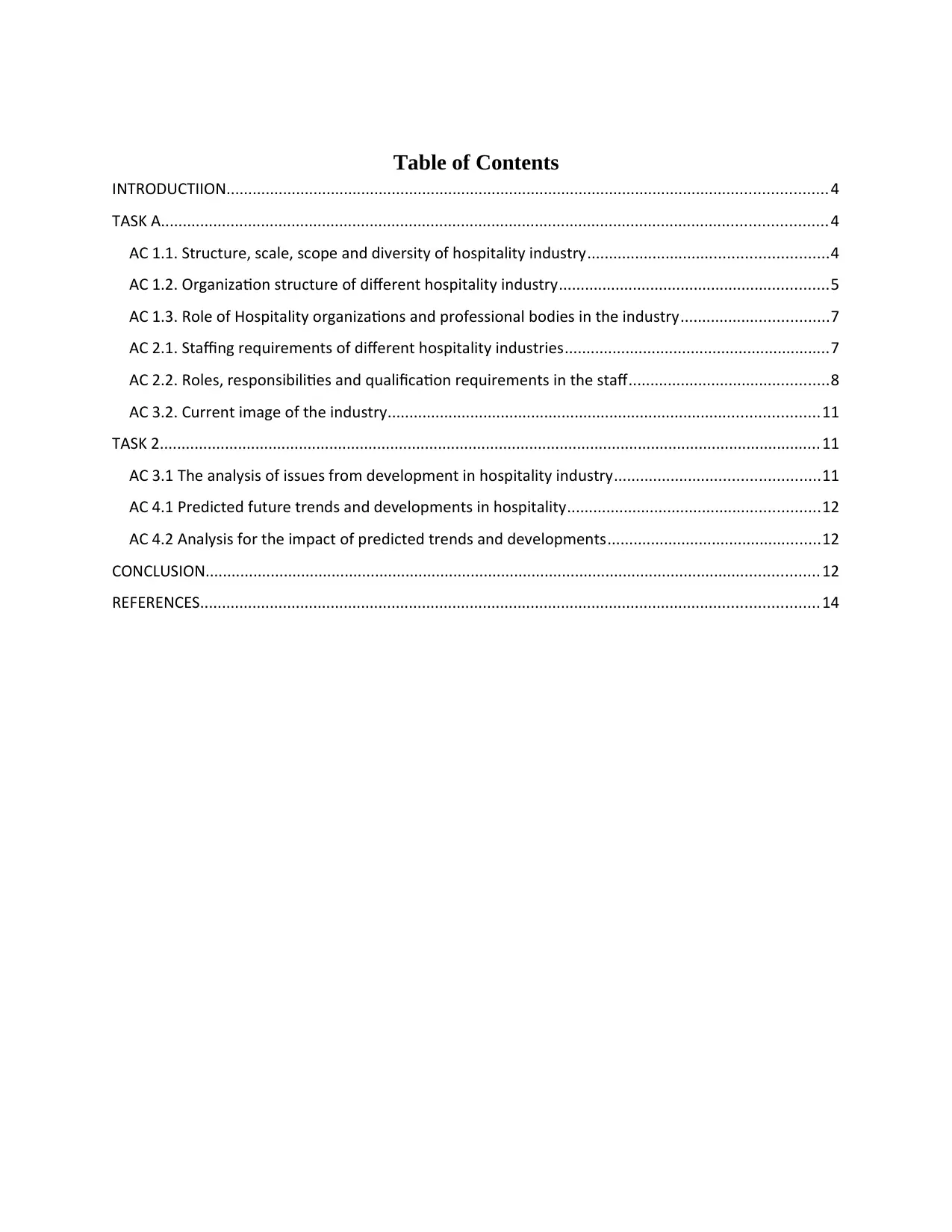
Table of Contents
INTRODUCTIION..........................................................................................................................................4
TASK A.........................................................................................................................................................4
AC 1.1. Structure, scale, scope and diversity of hospitality industry.......................................................4
AC 1.2. Organization structure of different hospitality industry..............................................................5
AC 1.3. Role of Hospitality organizations and professional bodies in the industry..................................7
AC 2.1. Staffing requirements of different hospitality industries.............................................................7
AC 2.2. Roles, responsibilities and qualification requirements in the staff..............................................8
AC 3.2. Current image of the industry...................................................................................................11
TASK 2........................................................................................................................................................11
AC 3.1 The analysis of issues from development in hospitality industry...............................................11
AC 4.1 Predicted future trends and developments in hospitality..........................................................12
AC 4.2 Analysis for the impact of predicted trends and developments.................................................12
CONCLUSION.............................................................................................................................................12
REFERENCES..............................................................................................................................................14
INTRODUCTIION..........................................................................................................................................4
TASK A.........................................................................................................................................................4
AC 1.1. Structure, scale, scope and diversity of hospitality industry.......................................................4
AC 1.2. Organization structure of different hospitality industry..............................................................5
AC 1.3. Role of Hospitality organizations and professional bodies in the industry..................................7
AC 2.1. Staffing requirements of different hospitality industries.............................................................7
AC 2.2. Roles, responsibilities and qualification requirements in the staff..............................................8
AC 3.2. Current image of the industry...................................................................................................11
TASK 2........................................................................................................................................................11
AC 3.1 The analysis of issues from development in hospitality industry...............................................11
AC 4.1 Predicted future trends and developments in hospitality..........................................................12
AC 4.2 Analysis for the impact of predicted trends and developments.................................................12
CONCLUSION.............................................................................................................................................12
REFERENCES..............................................................................................................................................14
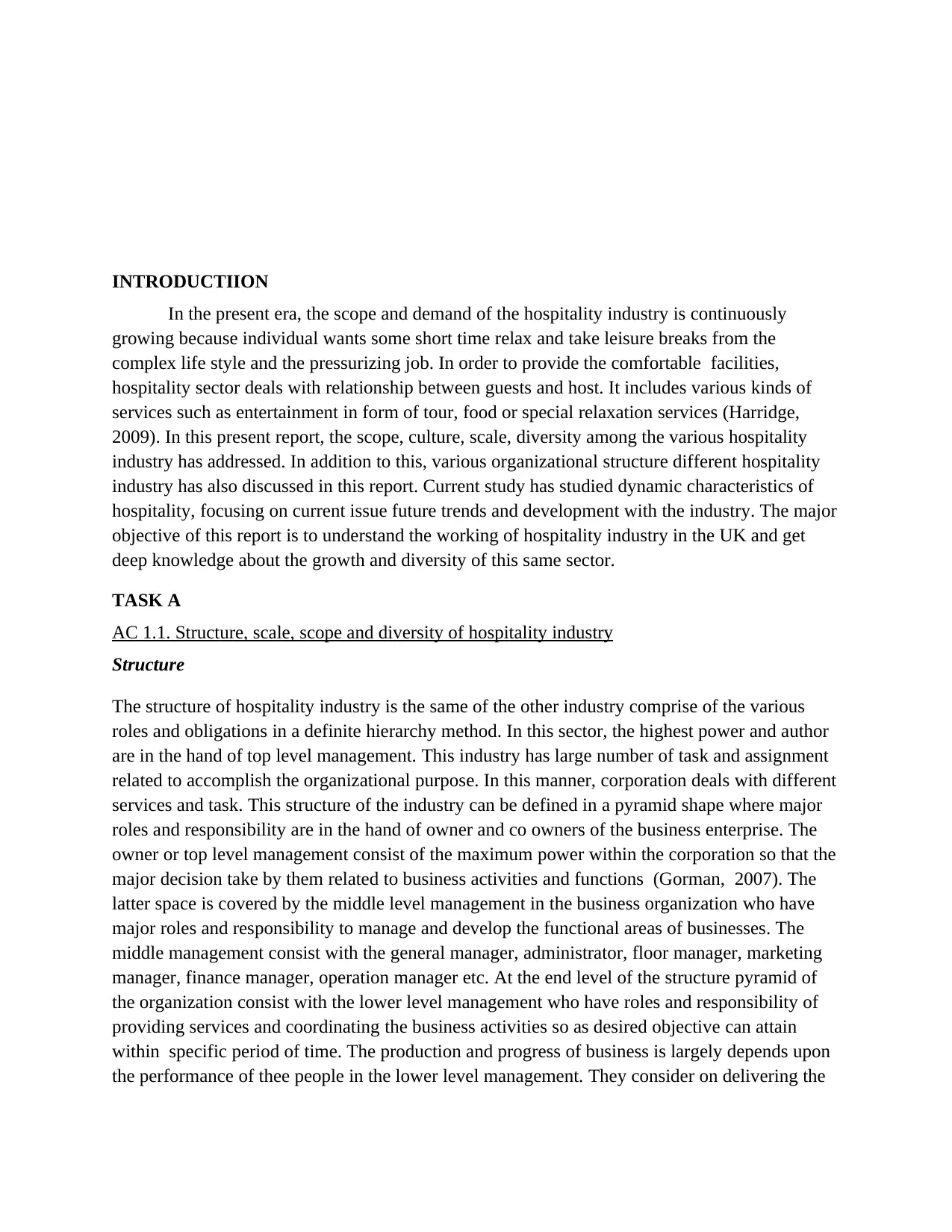
INTRODUCTIION
In the present era, the scope and demand of the hospitality industry is continuously
growing because individual wants some short time relax and take leisure breaks from the
complex life style and the pressurizing job. In order to provide the comfortable facilities,
hospitality sector deals with relationship between guests and host. It includes various kinds of
services such as entertainment in form of tour, food or special relaxation services (Harridge,
2009). In this present report, the scope, culture, scale, diversity among the various hospitality
industry has addressed. In addition to this, various organizational structure different hospitality
industry has also discussed in this report. Current study has studied dynamic characteristics of
hospitality, focusing on current issue future trends and development with the industry. The major
objective of this report is to understand the working of hospitality industry in the UK and get
deep knowledge about the growth and diversity of this same sector.
TASK A
AC 1.1. Structure, scale, scope and diversity of hospitality industry
Structure
The structure of hospitality industry is the same of the other industry comprise of the various
roles and obligations in a definite hierarchy method. In this sector, the highest power and author
are in the hand of top level management. This industry has large number of task and assignment
related to accomplish the organizational purpose. In this manner, corporation deals with different
services and task. This structure of the industry can be defined in a pyramid shape where major
roles and responsibility are in the hand of owner and co owners of the business enterprise. The
owner or top level management consist of the maximum power within the corporation so that the
major decision take by them related to business activities and functions (Gorman, 2007). The
latter space is covered by the middle level management in the business organization who have
major roles and responsibility to manage and develop the functional areas of businesses. The
middle management consist with the general manager, administrator, floor manager, marketing
manager, finance manager, operation manager etc. At the end level of the structure pyramid of
the organization consist with the lower level management who have roles and responsibility of
providing services and coordinating the business activities so as desired objective can attain
within specific period of time. The production and progress of business is largely depends upon
the performance of thee people in the lower level management. They consider on delivering the
In the present era, the scope and demand of the hospitality industry is continuously
growing because individual wants some short time relax and take leisure breaks from the
complex life style and the pressurizing job. In order to provide the comfortable facilities,
hospitality sector deals with relationship between guests and host. It includes various kinds of
services such as entertainment in form of tour, food or special relaxation services (Harridge,
2009). In this present report, the scope, culture, scale, diversity among the various hospitality
industry has addressed. In addition to this, various organizational structure different hospitality
industry has also discussed in this report. Current study has studied dynamic characteristics of
hospitality, focusing on current issue future trends and development with the industry. The major
objective of this report is to understand the working of hospitality industry in the UK and get
deep knowledge about the growth and diversity of this same sector.
TASK A
AC 1.1. Structure, scale, scope and diversity of hospitality industry
Structure
The structure of hospitality industry is the same of the other industry comprise of the various
roles and obligations in a definite hierarchy method. In this sector, the highest power and author
are in the hand of top level management. This industry has large number of task and assignment
related to accomplish the organizational purpose. In this manner, corporation deals with different
services and task. This structure of the industry can be defined in a pyramid shape where major
roles and responsibility are in the hand of owner and co owners of the business enterprise. The
owner or top level management consist of the maximum power within the corporation so that the
major decision take by them related to business activities and functions (Gorman, 2007). The
latter space is covered by the middle level management in the business organization who have
major roles and responsibility to manage and develop the functional areas of businesses. The
middle management consist with the general manager, administrator, floor manager, marketing
manager, finance manager, operation manager etc. At the end level of the structure pyramid of
the organization consist with the lower level management who have roles and responsibility of
providing services and coordinating the business activities so as desired objective can attain
within specific period of time. The production and progress of business is largely depends upon
the performance of thee people in the lower level management. They consider on delivering the
⊘ This is a preview!⊘
Do you want full access?
Subscribe today to unlock all pages.

Trusted by 1+ million students worldwide
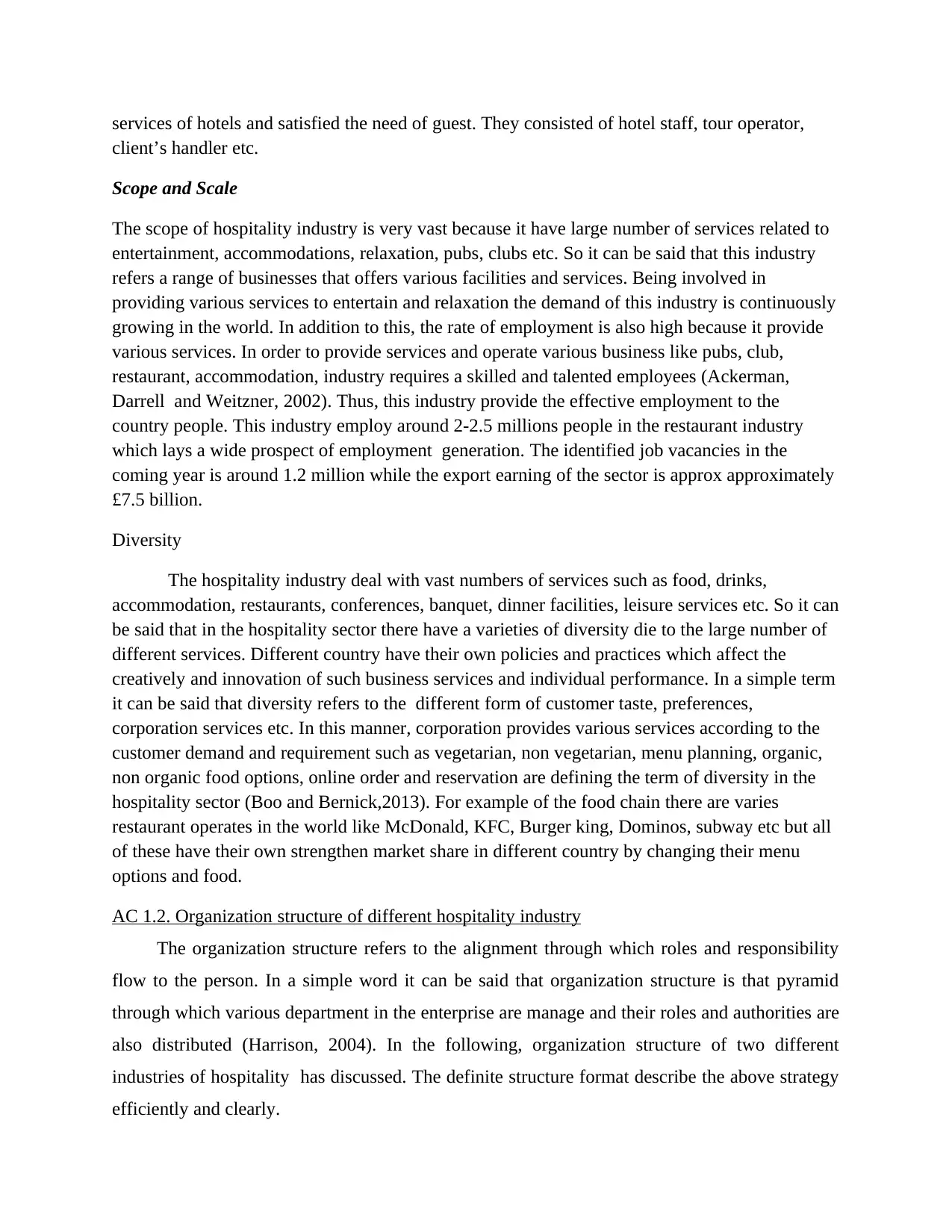
services of hotels and satisfied the need of guest. They consisted of hotel staff, tour operator,
client’s handler etc.
Scope and Scale
The scope of hospitality industry is very vast because it have large number of services related to
entertainment, accommodations, relaxation, pubs, clubs etc. So it can be said that this industry
refers a range of businesses that offers various facilities and services. Being involved in
providing various services to entertain and relaxation the demand of this industry is continuously
growing in the world. In addition to this, the rate of employment is also high because it provide
various services. In order to provide services and operate various business like pubs, club,
restaurant, accommodation, industry requires a skilled and talented employees (Ackerman,
Darrell and Weitzner, 2002). Thus, this industry provide the effective employment to the
country people. This industry employ around 2-2.5 millions people in the restaurant industry
which lays a wide prospect of employment generation. The identified job vacancies in the
coming year is around 1.2 million while the export earning of the sector is approx approximately
£7.5 billion.
Diversity
The hospitality industry deal with vast numbers of services such as food, drinks,
accommodation, restaurants, conferences, banquet, dinner facilities, leisure services etc. So it can
be said that in the hospitality sector there have a varieties of diversity die to the large number of
different services. Different country have their own policies and practices which affect the
creatively and innovation of such business services and individual performance. In a simple term
it can be said that diversity refers to the different form of customer taste, preferences,
corporation services etc. In this manner, corporation provides various services according to the
customer demand and requirement such as vegetarian, non vegetarian, menu planning, organic,
non organic food options, online order and reservation are defining the term of diversity in the
hospitality sector (Boo and Bernick,2013). For example of the food chain there are varies
restaurant operates in the world like McDonald, KFC, Burger king, Dominos, subway etc but all
of these have their own strengthen market share in different country by changing their menu
options and food.
AC 1.2. Organization structure of different hospitality industry
The organization structure refers to the alignment through which roles and responsibility
flow to the person. In a simple word it can be said that organization structure is that pyramid
through which various department in the enterprise are manage and their roles and authorities are
also distributed (Harrison, 2004). In the following, organization structure of two different
industries of hospitality has discussed. The definite structure format describe the above strategy
efficiently and clearly.
client’s handler etc.
Scope and Scale
The scope of hospitality industry is very vast because it have large number of services related to
entertainment, accommodations, relaxation, pubs, clubs etc. So it can be said that this industry
refers a range of businesses that offers various facilities and services. Being involved in
providing various services to entertain and relaxation the demand of this industry is continuously
growing in the world. In addition to this, the rate of employment is also high because it provide
various services. In order to provide services and operate various business like pubs, club,
restaurant, accommodation, industry requires a skilled and talented employees (Ackerman,
Darrell and Weitzner, 2002). Thus, this industry provide the effective employment to the
country people. This industry employ around 2-2.5 millions people in the restaurant industry
which lays a wide prospect of employment generation. The identified job vacancies in the
coming year is around 1.2 million while the export earning of the sector is approx approximately
£7.5 billion.
Diversity
The hospitality industry deal with vast numbers of services such as food, drinks,
accommodation, restaurants, conferences, banquet, dinner facilities, leisure services etc. So it can
be said that in the hospitality sector there have a varieties of diversity die to the large number of
different services. Different country have their own policies and practices which affect the
creatively and innovation of such business services and individual performance. In a simple term
it can be said that diversity refers to the different form of customer taste, preferences,
corporation services etc. In this manner, corporation provides various services according to the
customer demand and requirement such as vegetarian, non vegetarian, menu planning, organic,
non organic food options, online order and reservation are defining the term of diversity in the
hospitality sector (Boo and Bernick,2013). For example of the food chain there are varies
restaurant operates in the world like McDonald, KFC, Burger king, Dominos, subway etc but all
of these have their own strengthen market share in different country by changing their menu
options and food.
AC 1.2. Organization structure of different hospitality industry
The organization structure refers to the alignment through which roles and responsibility
flow to the person. In a simple word it can be said that organization structure is that pyramid
through which various department in the enterprise are manage and their roles and authorities are
also distributed (Harrison, 2004). In the following, organization structure of two different
industries of hospitality has discussed. The definite structure format describe the above strategy
efficiently and clearly.
Paraphrase This Document
Need a fresh take? Get an instant paraphrase of this document with our AI Paraphraser
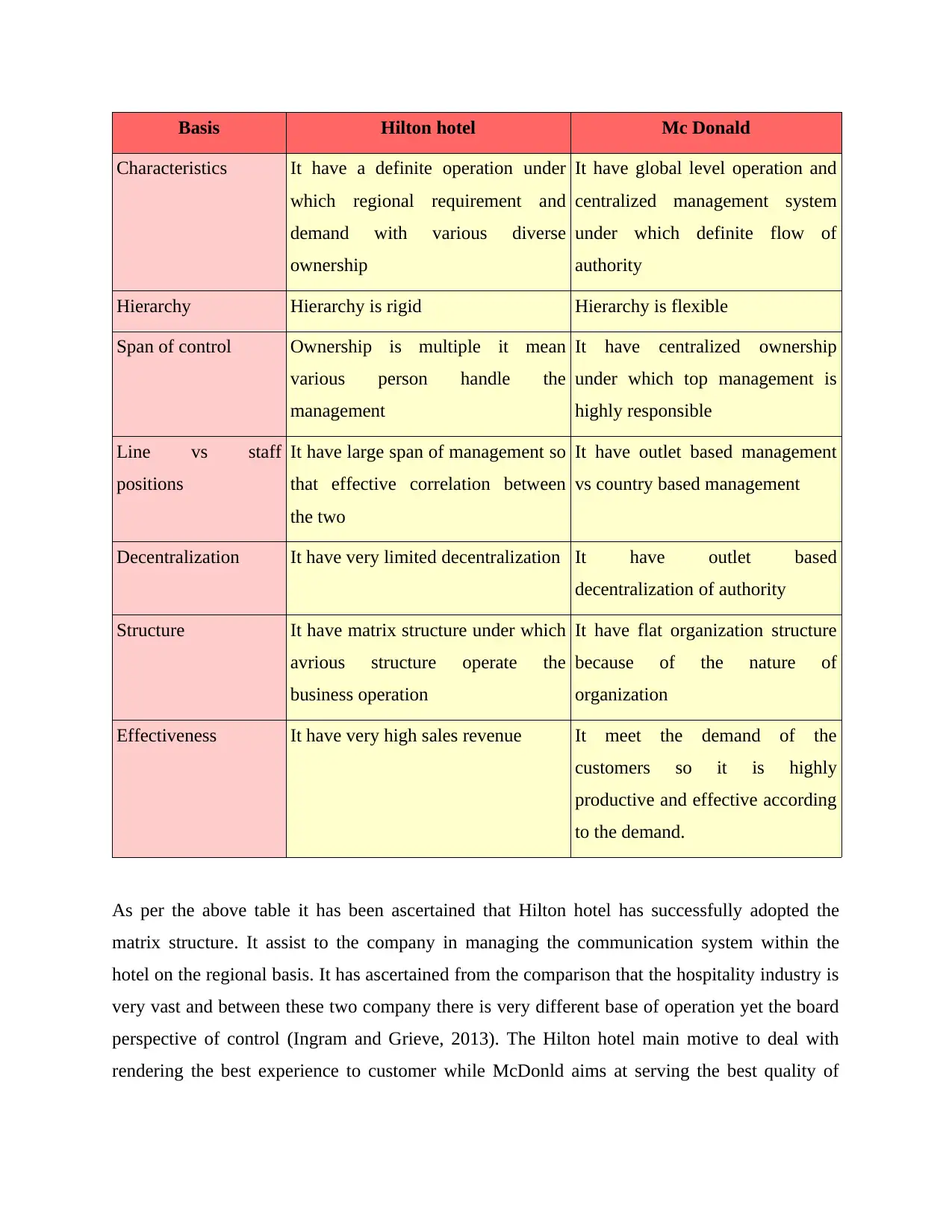
Basis Hilton hotel Mc Donald
Characteristics It have a definite operation under
which regional requirement and
demand with various diverse
ownership
It have global level operation and
centralized management system
under which definite flow of
authority
Hierarchy Hierarchy is rigid Hierarchy is flexible
Span of control Ownership is multiple it mean
various person handle the
management
It have centralized ownership
under which top management is
highly responsible
Line vs staff
positions
It have large span of management so
that effective correlation between
the two
It have outlet based management
vs country based management
Decentralization It have very limited decentralization It have outlet based
decentralization of authority
Structure It have matrix structure under which
avrious structure operate the
business operation
It have flat organization structure
because of the nature of
organization
Effectiveness It have very high sales revenue It meet the demand of the
customers so it is highly
productive and effective according
to the demand.
As per the above table it has been ascertained that Hilton hotel has successfully adopted the
matrix structure. It assist to the company in managing the communication system within the
hotel on the regional basis. It has ascertained from the comparison that the hospitality industry is
very vast and between these two company there is very different base of operation yet the board
perspective of control (Ingram and Grieve, 2013). The Hilton hotel main motive to deal with
rendering the best experience to customer while McDonld aims at serving the best quality of
Characteristics It have a definite operation under
which regional requirement and
demand with various diverse
ownership
It have global level operation and
centralized management system
under which definite flow of
authority
Hierarchy Hierarchy is rigid Hierarchy is flexible
Span of control Ownership is multiple it mean
various person handle the
management
It have centralized ownership
under which top management is
highly responsible
Line vs staff
positions
It have large span of management so
that effective correlation between
the two
It have outlet based management
vs country based management
Decentralization It have very limited decentralization It have outlet based
decentralization of authority
Structure It have matrix structure under which
avrious structure operate the
business operation
It have flat organization structure
because of the nature of
organization
Effectiveness It have very high sales revenue It meet the demand of the
customers so it is highly
productive and effective according
to the demand.
As per the above table it has been ascertained that Hilton hotel has successfully adopted the
matrix structure. It assist to the company in managing the communication system within the
hotel on the regional basis. It has ascertained from the comparison that the hospitality industry is
very vast and between these two company there is very different base of operation yet the board
perspective of control (Ingram and Grieve, 2013). The Hilton hotel main motive to deal with
rendering the best experience to customer while McDonld aims at serving the best quality of
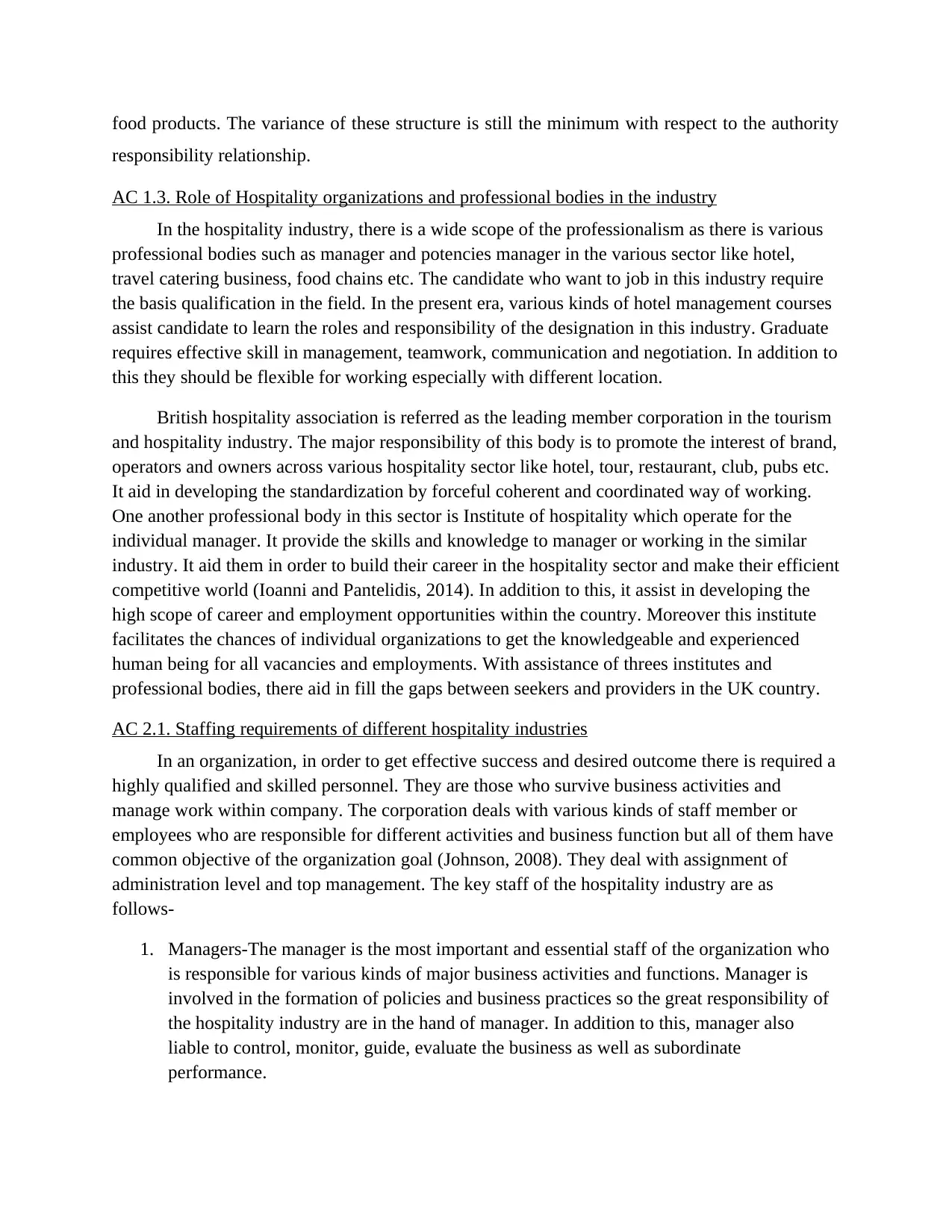
food products. The variance of these structure is still the minimum with respect to the authority
responsibility relationship.
AC 1.3. Role of Hospitality organizations and professional bodies in the industry
In the hospitality industry, there is a wide scope of the professionalism as there is various
professional bodies such as manager and potencies manager in the various sector like hotel,
travel catering business, food chains etc. The candidate who want to job in this industry require
the basis qualification in the field. In the present era, various kinds of hotel management courses
assist candidate to learn the roles and responsibility of the designation in this industry. Graduate
requires effective skill in management, teamwork, communication and negotiation. In addition to
this they should be flexible for working especially with different location.
British hospitality association is referred as the leading member corporation in the tourism
and hospitality industry. The major responsibility of this body is to promote the interest of brand,
operators and owners across various hospitality sector like hotel, tour, restaurant, club, pubs etc.
It aid in developing the standardization by forceful coherent and coordinated way of working.
One another professional body in this sector is Institute of hospitality which operate for the
individual manager. It provide the skills and knowledge to manager or working in the similar
industry. It aid them in order to build their career in the hospitality sector and make their efficient
competitive world (Ioanni and Pantelidis, 2014). In addition to this, it assist in developing the
high scope of career and employment opportunities within the country. Moreover this institute
facilitates the chances of individual organizations to get the knowledgeable and experienced
human being for all vacancies and employments. With assistance of threes institutes and
professional bodies, there aid in fill the gaps between seekers and providers in the UK country.
AC 2.1. Staffing requirements of different hospitality industries
In an organization, in order to get effective success and desired outcome there is required a
highly qualified and skilled personnel. They are those who survive business activities and
manage work within company. The corporation deals with various kinds of staff member or
employees who are responsible for different activities and business function but all of them have
common objective of the organization goal (Johnson, 2008). They deal with assignment of
administration level and top management. The key staff of the hospitality industry are as
follows-
1. Managers-The manager is the most important and essential staff of the organization who
is responsible for various kinds of major business activities and functions. Manager is
involved in the formation of policies and business practices so the great responsibility of
the hospitality industry are in the hand of manager. In addition to this, manager also
liable to control, monitor, guide, evaluate the business as well as subordinate
performance.
responsibility relationship.
AC 1.3. Role of Hospitality organizations and professional bodies in the industry
In the hospitality industry, there is a wide scope of the professionalism as there is various
professional bodies such as manager and potencies manager in the various sector like hotel,
travel catering business, food chains etc. The candidate who want to job in this industry require
the basis qualification in the field. In the present era, various kinds of hotel management courses
assist candidate to learn the roles and responsibility of the designation in this industry. Graduate
requires effective skill in management, teamwork, communication and negotiation. In addition to
this they should be flexible for working especially with different location.
British hospitality association is referred as the leading member corporation in the tourism
and hospitality industry. The major responsibility of this body is to promote the interest of brand,
operators and owners across various hospitality sector like hotel, tour, restaurant, club, pubs etc.
It aid in developing the standardization by forceful coherent and coordinated way of working.
One another professional body in this sector is Institute of hospitality which operate for the
individual manager. It provide the skills and knowledge to manager or working in the similar
industry. It aid them in order to build their career in the hospitality sector and make their efficient
competitive world (Ioanni and Pantelidis, 2014). In addition to this, it assist in developing the
high scope of career and employment opportunities within the country. Moreover this institute
facilitates the chances of individual organizations to get the knowledgeable and experienced
human being for all vacancies and employments. With assistance of threes institutes and
professional bodies, there aid in fill the gaps between seekers and providers in the UK country.
AC 2.1. Staffing requirements of different hospitality industries
In an organization, in order to get effective success and desired outcome there is required a
highly qualified and skilled personnel. They are those who survive business activities and
manage work within company. The corporation deals with various kinds of staff member or
employees who are responsible for different activities and business function but all of them have
common objective of the organization goal (Johnson, 2008). They deal with assignment of
administration level and top management. The key staff of the hospitality industry are as
follows-
1. Managers-The manager is the most important and essential staff of the organization who
is responsible for various kinds of major business activities and functions. Manager is
involved in the formation of policies and business practices so the great responsibility of
the hospitality industry are in the hand of manager. In addition to this, manager also
liable to control, monitor, guide, evaluate the business as well as subordinate
performance.
⊘ This is a preview!⊘
Do you want full access?
Subscribe today to unlock all pages.

Trusted by 1+ million students worldwide
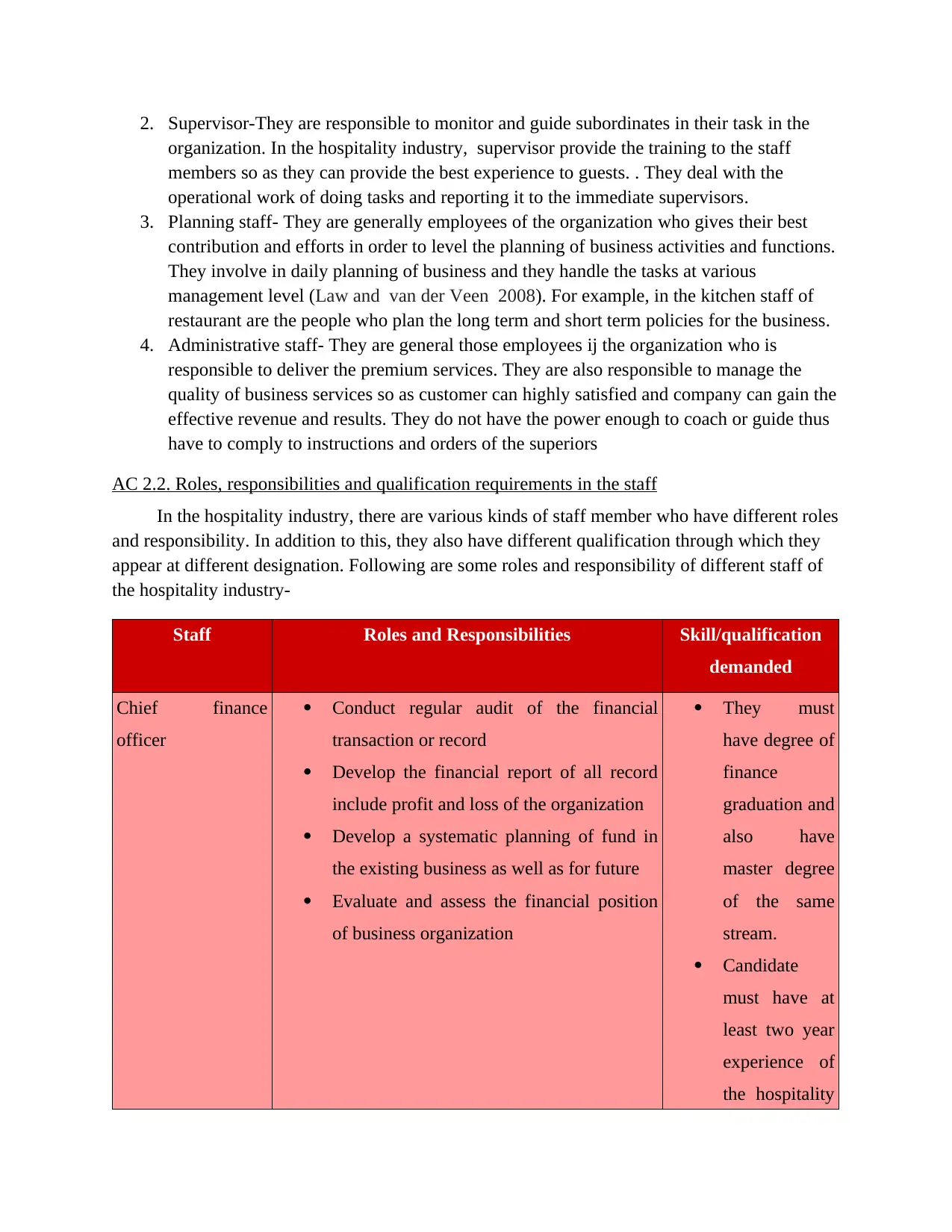
2. Supervisor-They are responsible to monitor and guide subordinates in their task in the
organization. In the hospitality industry, supervisor provide the training to the staff
members so as they can provide the best experience to guests. . They deal with the
operational work of doing tasks and reporting it to the immediate supervisors.
3. Planning staff- They are generally employees of the organization who gives their best
contribution and efforts in order to level the planning of business activities and functions.
They involve in daily planning of business and they handle the tasks at various
management level (Law and van der Veen 2008). For example, in the kitchen staff of
restaurant are the people who plan the long term and short term policies for the business.
4. Administrative staff- They are general those employees ij the organization who is
responsible to deliver the premium services. They are also responsible to manage the
quality of business services so as customer can highly satisfied and company can gain the
effective revenue and results. They do not have the power enough to coach or guide thus
have to comply to instructions and orders of the superiors
AC 2.2. Roles, responsibilities and qualification requirements in the staff
In the hospitality industry, there are various kinds of staff member who have different roles
and responsibility. In addition to this, they also have different qualification through which they
appear at different designation. Following are some roles and responsibility of different staff of
the hospitality industry-
Staff Roles and Responsibilities Skill/qualification
demanded
Chief finance
officer
Conduct regular audit of the financial
transaction or record
Develop the financial report of all record
include profit and loss of the organization
Develop a systematic planning of fund in
the existing business as well as for future
Evaluate and assess the financial position
of business organization
They must
have degree of
finance
graduation and
also have
master degree
of the same
stream.
Candidate
must have at
least two year
experience of
the hospitality
organization. In the hospitality industry, supervisor provide the training to the staff
members so as they can provide the best experience to guests. . They deal with the
operational work of doing tasks and reporting it to the immediate supervisors.
3. Planning staff- They are generally employees of the organization who gives their best
contribution and efforts in order to level the planning of business activities and functions.
They involve in daily planning of business and they handle the tasks at various
management level (Law and van der Veen 2008). For example, in the kitchen staff of
restaurant are the people who plan the long term and short term policies for the business.
4. Administrative staff- They are general those employees ij the organization who is
responsible to deliver the premium services. They are also responsible to manage the
quality of business services so as customer can highly satisfied and company can gain the
effective revenue and results. They do not have the power enough to coach or guide thus
have to comply to instructions and orders of the superiors
AC 2.2. Roles, responsibilities and qualification requirements in the staff
In the hospitality industry, there are various kinds of staff member who have different roles
and responsibility. In addition to this, they also have different qualification through which they
appear at different designation. Following are some roles and responsibility of different staff of
the hospitality industry-
Staff Roles and Responsibilities Skill/qualification
demanded
Chief finance
officer
Conduct regular audit of the financial
transaction or record
Develop the financial report of all record
include profit and loss of the organization
Develop a systematic planning of fund in
the existing business as well as for future
Evaluate and assess the financial position
of business organization
They must
have degree of
finance
graduation and
also have
master degree
of the same
stream.
Candidate
must have at
least two year
experience of
the hospitality
Paraphrase This Document
Need a fresh take? Get an instant paraphrase of this document with our AI Paraphraser
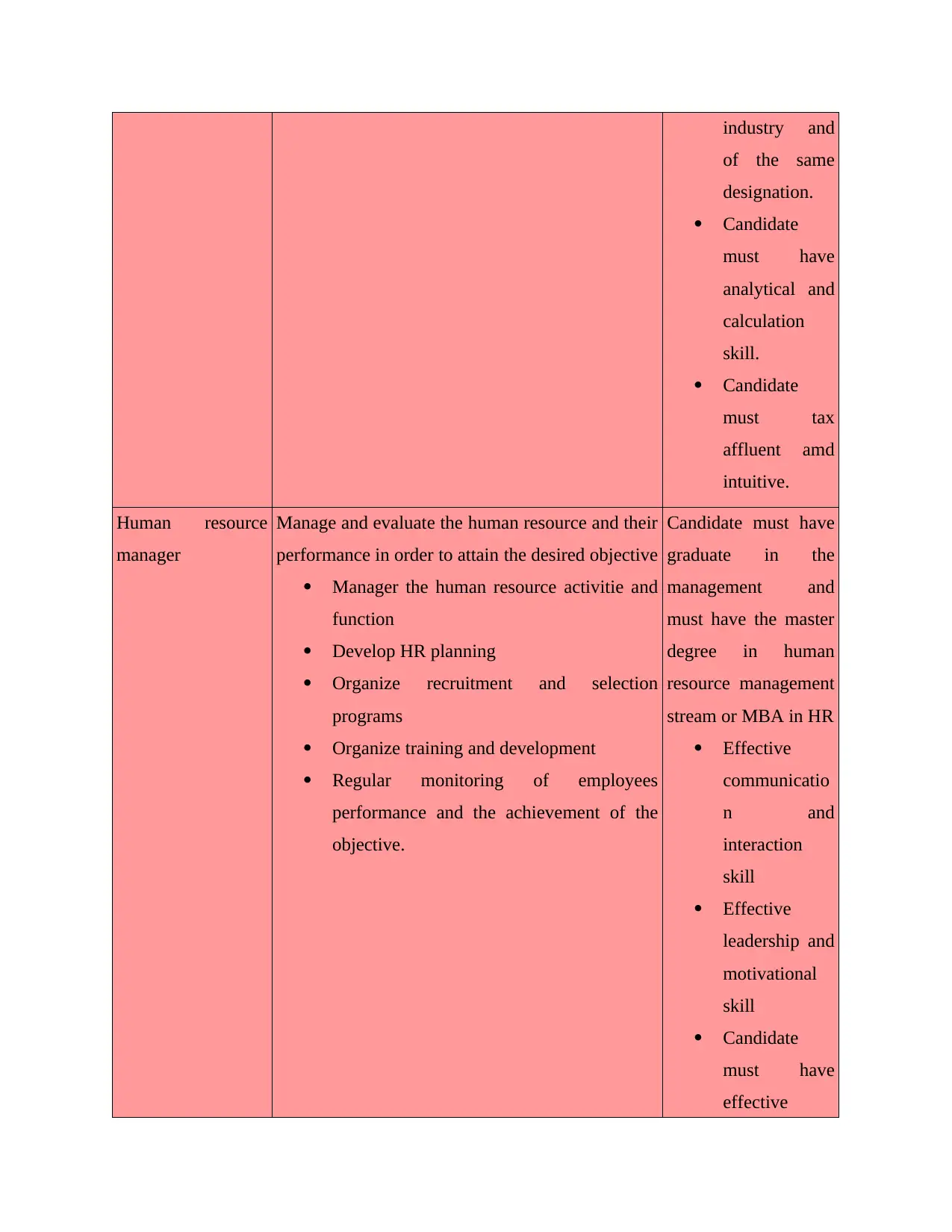
industry and
of the same
designation.
Candidate
must have
analytical and
calculation
skill.
Candidate
must tax
affluent amd
intuitive.
Human resource
manager
Manage and evaluate the human resource and their
performance in order to attain the desired objective
Manager the human resource activitie and
function
Develop HR planning
Organize recruitment and selection
programs
Organize training and development
Regular monitoring of employees
performance and the achievement of the
objective.
Candidate must have
graduate in the
management and
must have the master
degree in human
resource management
stream or MBA in HR
Effective
communicatio
n and
interaction
skill
Effective
leadership and
motivational
skill
Candidate
must have
effective
of the same
designation.
Candidate
must have
analytical and
calculation
skill.
Candidate
must tax
affluent amd
intuitive.
Human resource
manager
Manage and evaluate the human resource and their
performance in order to attain the desired objective
Manager the human resource activitie and
function
Develop HR planning
Organize recruitment and selection
programs
Organize training and development
Regular monitoring of employees
performance and the achievement of the
objective.
Candidate must have
graduate in the
management and
must have the master
degree in human
resource management
stream or MBA in HR
Effective
communicatio
n and
interaction
skill
Effective
leadership and
motivational
skill
Candidate
must have
effective
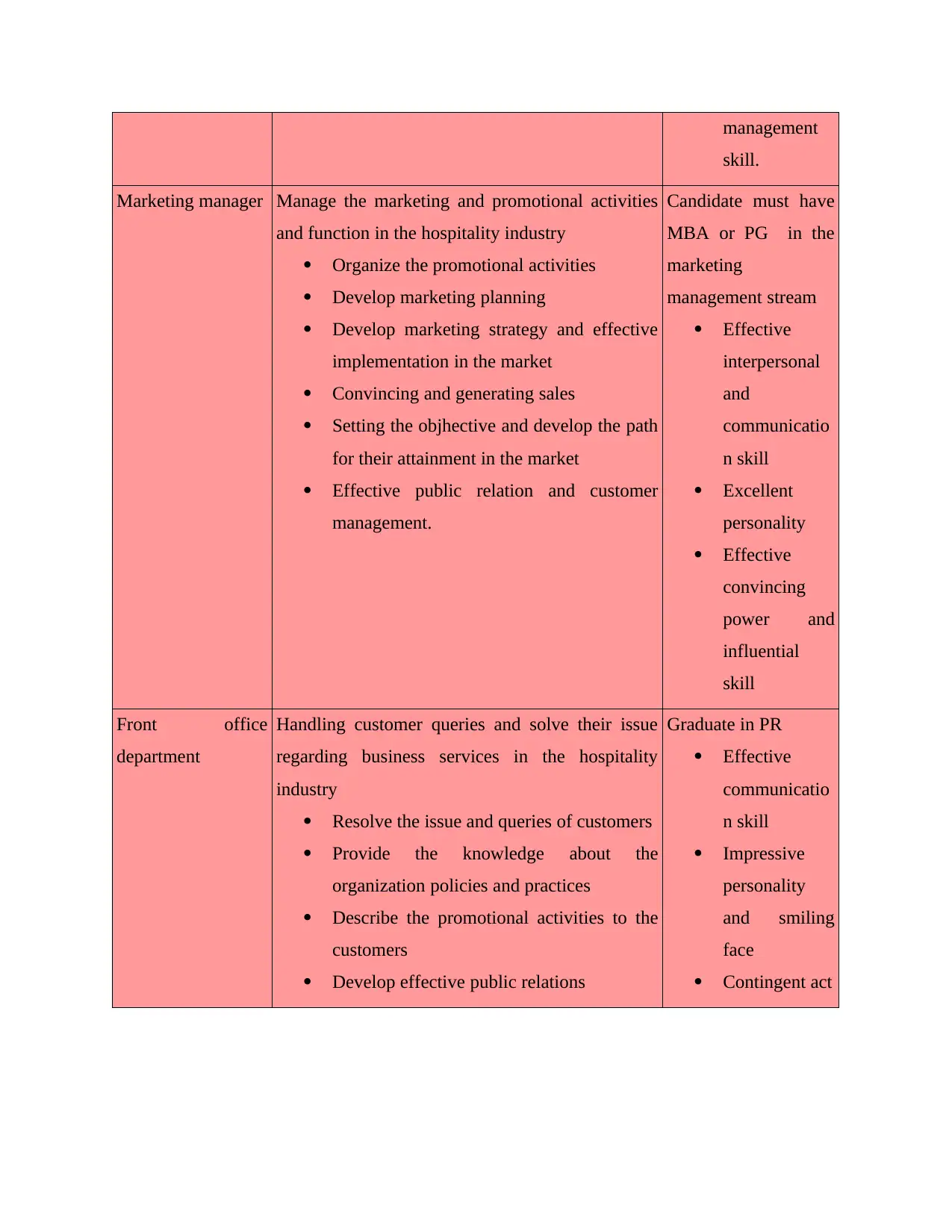
management
skill.
Marketing manager Manage the marketing and promotional activities
and function in the hospitality industry
Organize the promotional activities
Develop marketing planning
Develop marketing strategy and effective
implementation in the market
Convincing and generating sales
Setting the objhective and develop the path
for their attainment in the market
Effective public relation and customer
management.
Candidate must have
MBA or PG in the
marketing
management stream
Effective
interpersonal
and
communicatio
n skill
Excellent
personality
Effective
convincing
power and
influential
skill
Front office
department
Handling customer queries and solve their issue
regarding business services in the hospitality
industry
Resolve the issue and queries of customers
Provide the knowledge about the
organization policies and practices
Describe the promotional activities to the
customers
Develop effective public relations
Graduate in PR
Effective
communicatio
n skill
Impressive
personality
and smiling
face
Contingent act
skill.
Marketing manager Manage the marketing and promotional activities
and function in the hospitality industry
Organize the promotional activities
Develop marketing planning
Develop marketing strategy and effective
implementation in the market
Convincing and generating sales
Setting the objhective and develop the path
for their attainment in the market
Effective public relation and customer
management.
Candidate must have
MBA or PG in the
marketing
management stream
Effective
interpersonal
and
communicatio
n skill
Excellent
personality
Effective
convincing
power and
influential
skill
Front office
department
Handling customer queries and solve their issue
regarding business services in the hospitality
industry
Resolve the issue and queries of customers
Provide the knowledge about the
organization policies and practices
Describe the promotional activities to the
customers
Develop effective public relations
Graduate in PR
Effective
communicatio
n skill
Impressive
personality
and smiling
face
Contingent act
⊘ This is a preview!⊘
Do you want full access?
Subscribe today to unlock all pages.

Trusted by 1+ million students worldwide
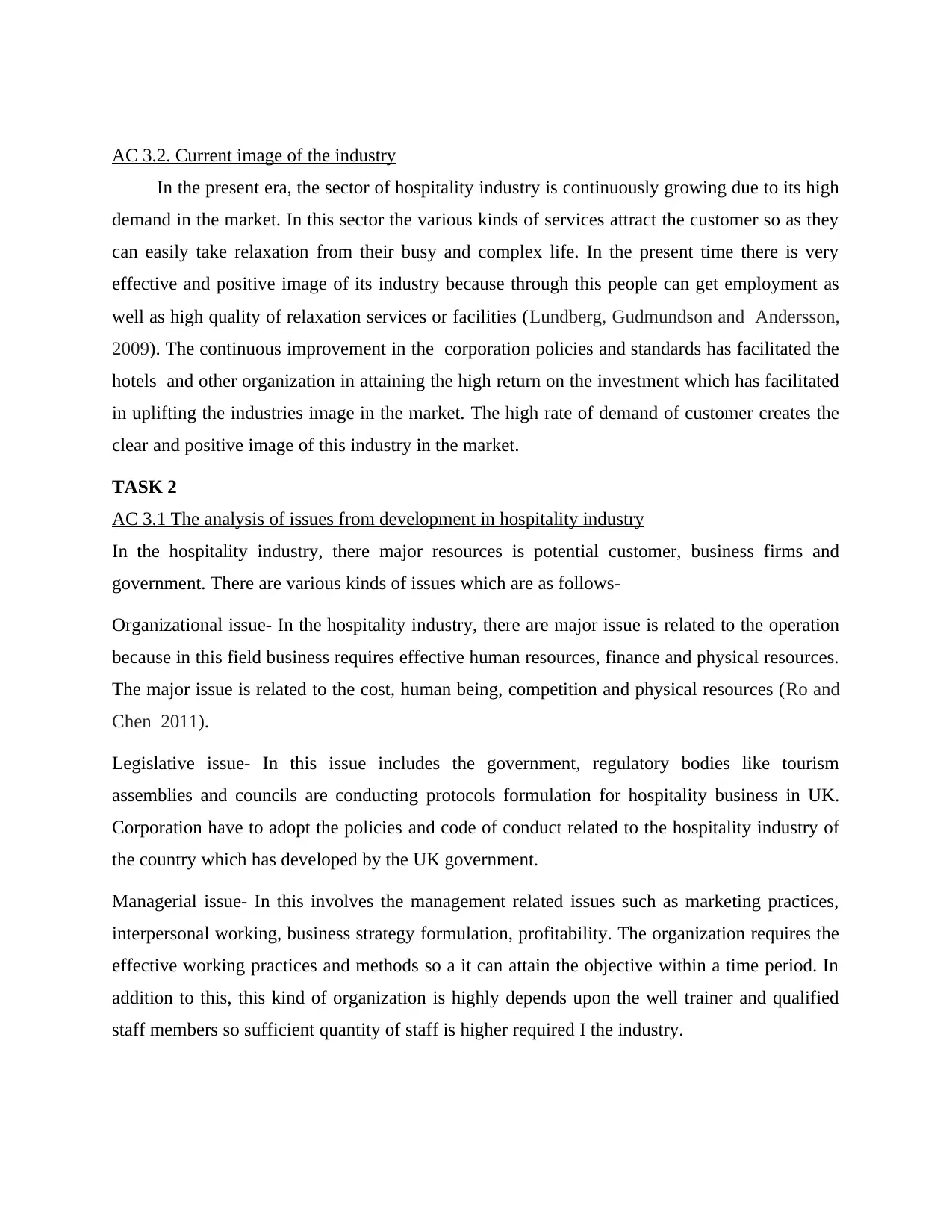
AC 3.2. Current image of the industry
In the present era, the sector of hospitality industry is continuously growing due to its high
demand in the market. In this sector the various kinds of services attract the customer so as they
can easily take relaxation from their busy and complex life. In the present time there is very
effective and positive image of its industry because through this people can get employment as
well as high quality of relaxation services or facilities (Lundberg, Gudmundson and Andersson,
2009). The continuous improvement in the corporation policies and standards has facilitated the
hotels and other organization in attaining the high return on the investment which has facilitated
in uplifting the industries image in the market. The high rate of demand of customer creates the
clear and positive image of this industry in the market.
TASK 2
AC 3.1 The analysis of issues from development in hospitality industry
In the hospitality industry, there major resources is potential customer, business firms and
government. There are various kinds of issues which are as follows-
Organizational issue- In the hospitality industry, there are major issue is related to the operation
because in this field business requires effective human resources, finance and physical resources.
The major issue is related to the cost, human being, competition and physical resources (Ro and
Chen 2011).
Legislative issue- In this issue includes the government, regulatory bodies like tourism
assemblies and councils are conducting protocols formulation for hospitality business in UK.
Corporation have to adopt the policies and code of conduct related to the hospitality industry of
the country which has developed by the UK government.
Managerial issue- In this involves the management related issues such as marketing practices,
interpersonal working, business strategy formulation, profitability. The organization requires the
effective working practices and methods so a it can attain the objective within a time period. In
addition to this, this kind of organization is highly depends upon the well trainer and qualified
staff members so sufficient quantity of staff is higher required I the industry.
In the present era, the sector of hospitality industry is continuously growing due to its high
demand in the market. In this sector the various kinds of services attract the customer so as they
can easily take relaxation from their busy and complex life. In the present time there is very
effective and positive image of its industry because through this people can get employment as
well as high quality of relaxation services or facilities (Lundberg, Gudmundson and Andersson,
2009). The continuous improvement in the corporation policies and standards has facilitated the
hotels and other organization in attaining the high return on the investment which has facilitated
in uplifting the industries image in the market. The high rate of demand of customer creates the
clear and positive image of this industry in the market.
TASK 2
AC 3.1 The analysis of issues from development in hospitality industry
In the hospitality industry, there major resources is potential customer, business firms and
government. There are various kinds of issues which are as follows-
Organizational issue- In the hospitality industry, there are major issue is related to the operation
because in this field business requires effective human resources, finance and physical resources.
The major issue is related to the cost, human being, competition and physical resources (Ro and
Chen 2011).
Legislative issue- In this issue includes the government, regulatory bodies like tourism
assemblies and councils are conducting protocols formulation for hospitality business in UK.
Corporation have to adopt the policies and code of conduct related to the hospitality industry of
the country which has developed by the UK government.
Managerial issue- In this involves the management related issues such as marketing practices,
interpersonal working, business strategy formulation, profitability. The organization requires the
effective working practices and methods so a it can attain the objective within a time period. In
addition to this, this kind of organization is highly depends upon the well trainer and qualified
staff members so sufficient quantity of staff is higher required I the industry.
Paraphrase This Document
Need a fresh take? Get an instant paraphrase of this document with our AI Paraphraser
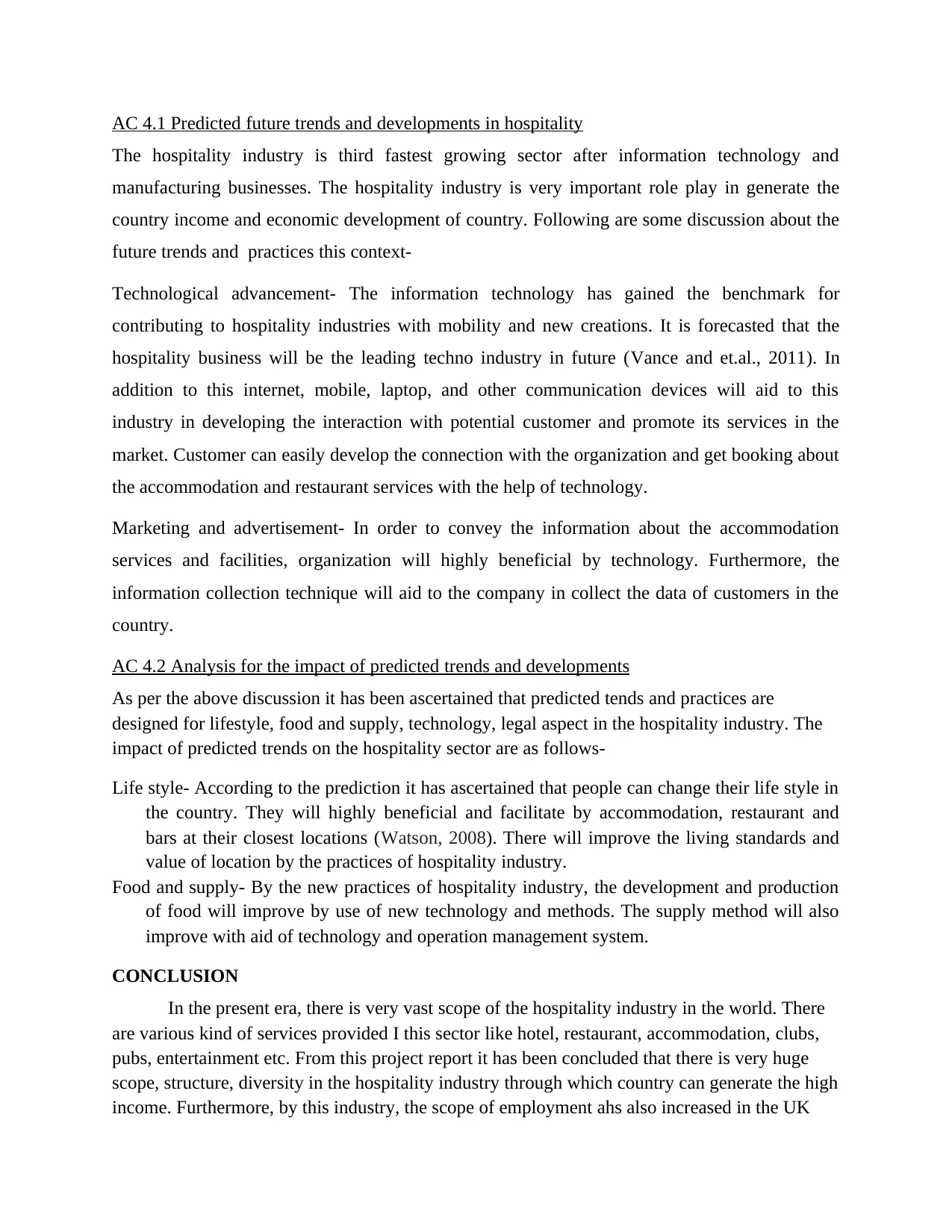
AC 4.1 Predicted future trends and developments in hospitality
The hospitality industry is third fastest growing sector after information technology and
manufacturing businesses. The hospitality industry is very important role play in generate the
country income and economic development of country. Following are some discussion about the
future trends and practices this context-
Technological advancement- The information technology has gained the benchmark for
contributing to hospitality industries with mobility and new creations. It is forecasted that the
hospitality business will be the leading techno industry in future (Vance and et.al., 2011). In
addition to this internet, mobile, laptop, and other communication devices will aid to this
industry in developing the interaction with potential customer and promote its services in the
market. Customer can easily develop the connection with the organization and get booking about
the accommodation and restaurant services with the help of technology.
Marketing and advertisement- In order to convey the information about the accommodation
services and facilities, organization will highly beneficial by technology. Furthermore, the
information collection technique will aid to the company in collect the data of customers in the
country.
AC 4.2 Analysis for the impact of predicted trends and developments
As per the above discussion it has been ascertained that predicted tends and practices are
designed for lifestyle, food and supply, technology, legal aspect in the hospitality industry. The
impact of predicted trends on the hospitality sector are as follows-
Life style- According to the prediction it has ascertained that people can change their life style in
the country. They will highly beneficial and facilitate by accommodation, restaurant and
bars at their closest locations (Watson, 2008). There will improve the living standards and
value of location by the practices of hospitality industry.
Food and supply- By the new practices of hospitality industry, the development and production
of food will improve by use of new technology and methods. The supply method will also
improve with aid of technology and operation management system.
CONCLUSION
In the present era, there is very vast scope of the hospitality industry in the world. There
are various kind of services provided I this sector like hotel, restaurant, accommodation, clubs,
pubs, entertainment etc. From this project report it has been concluded that there is very huge
scope, structure, diversity in the hospitality industry through which country can generate the high
income. Furthermore, by this industry, the scope of employment ahs also increased in the UK
The hospitality industry is third fastest growing sector after information technology and
manufacturing businesses. The hospitality industry is very important role play in generate the
country income and economic development of country. Following are some discussion about the
future trends and practices this context-
Technological advancement- The information technology has gained the benchmark for
contributing to hospitality industries with mobility and new creations. It is forecasted that the
hospitality business will be the leading techno industry in future (Vance and et.al., 2011). In
addition to this internet, mobile, laptop, and other communication devices will aid to this
industry in developing the interaction with potential customer and promote its services in the
market. Customer can easily develop the connection with the organization and get booking about
the accommodation and restaurant services with the help of technology.
Marketing and advertisement- In order to convey the information about the accommodation
services and facilities, organization will highly beneficial by technology. Furthermore, the
information collection technique will aid to the company in collect the data of customers in the
country.
AC 4.2 Analysis for the impact of predicted trends and developments
As per the above discussion it has been ascertained that predicted tends and practices are
designed for lifestyle, food and supply, technology, legal aspect in the hospitality industry. The
impact of predicted trends on the hospitality sector are as follows-
Life style- According to the prediction it has ascertained that people can change their life style in
the country. They will highly beneficial and facilitate by accommodation, restaurant and
bars at their closest locations (Watson, 2008). There will improve the living standards and
value of location by the practices of hospitality industry.
Food and supply- By the new practices of hospitality industry, the development and production
of food will improve by use of new technology and methods. The supply method will also
improve with aid of technology and operation management system.
CONCLUSION
In the present era, there is very vast scope of the hospitality industry in the world. There
are various kind of services provided I this sector like hotel, restaurant, accommodation, clubs,
pubs, entertainment etc. From this project report it has been concluded that there is very huge
scope, structure, diversity in the hospitality industry through which country can generate the high
income. Furthermore, by this industry, the scope of employment ahs also increased in the UK
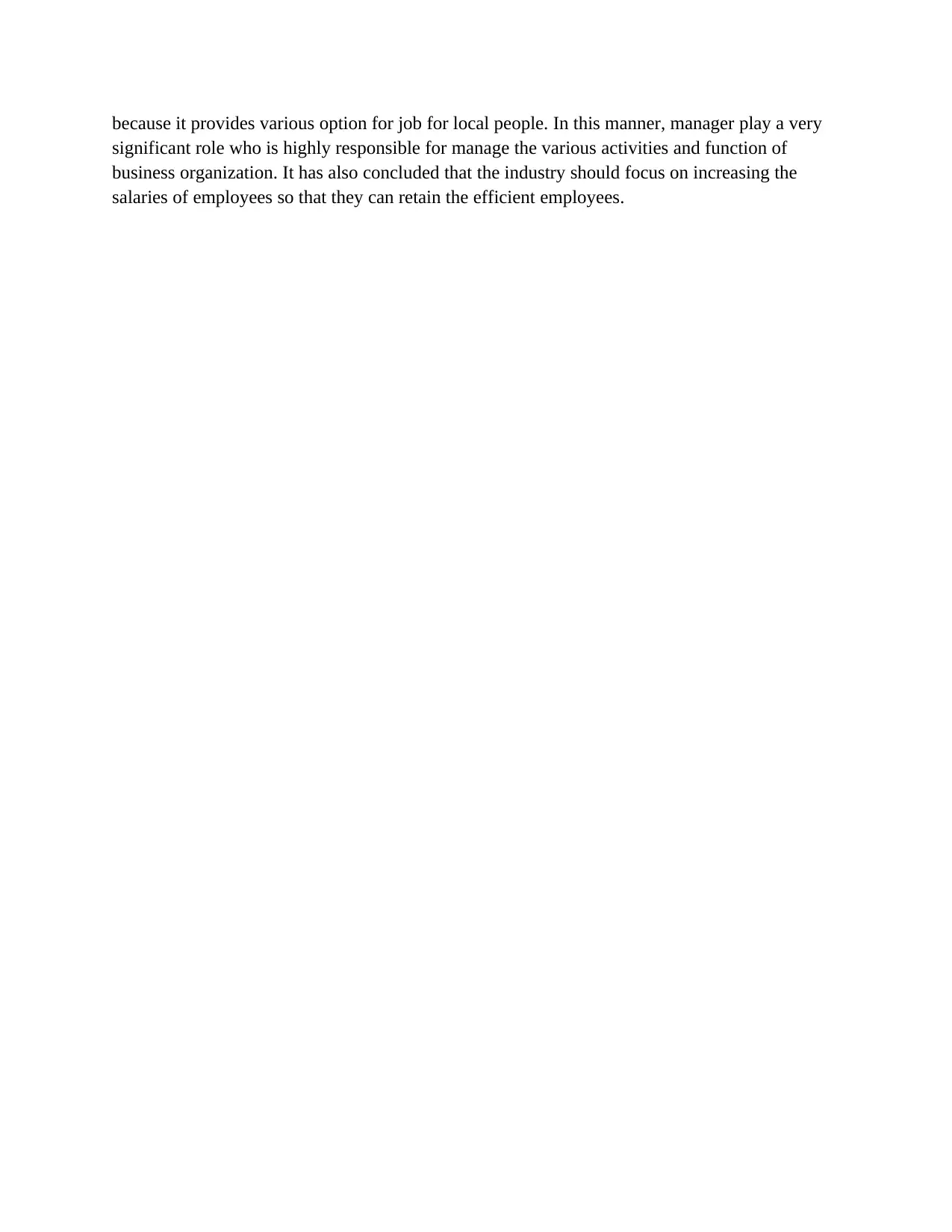
because it provides various option for job for local people. In this manner, manager play a very
significant role who is highly responsible for manage the various activities and function of
business organization. It has also concluded that the industry should focus on increasing the
salaries of employees so that they can retain the efficient employees.
significant role who is highly responsible for manage the various activities and function of
business organization. It has also concluded that the industry should focus on increasing the
salaries of employees so that they can retain the efficient employees.
⊘ This is a preview!⊘
Do you want full access?
Subscribe today to unlock all pages.

Trusted by 1+ million students worldwide
1 out of 14
Related Documents
Your All-in-One AI-Powered Toolkit for Academic Success.
+13062052269
info@desklib.com
Available 24*7 on WhatsApp / Email
![[object Object]](/_next/static/media/star-bottom.7253800d.svg)
Unlock your academic potential
Copyright © 2020–2025 A2Z Services. All Rights Reserved. Developed and managed by ZUCOL.





